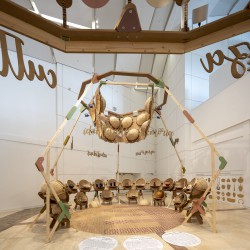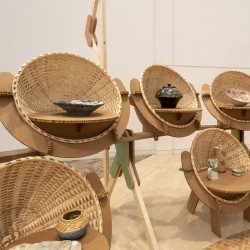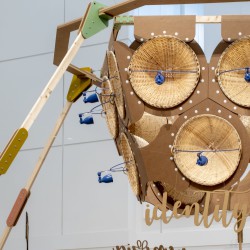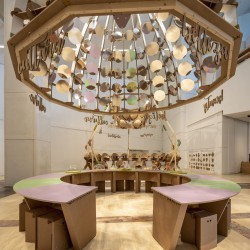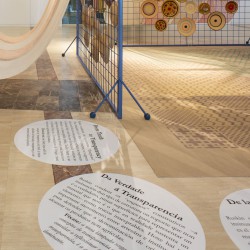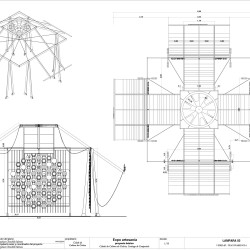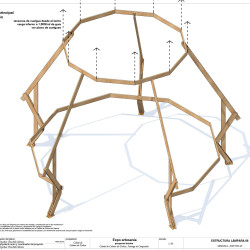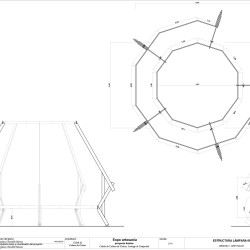Izaskun Chinchilla Architects . photos: © Héctor Santos Díez
Craftsmanship was very prestigious and received great public attention with the Arts & Crafts movement, which was born in England and spread through Europe before Modernity. Our exhibition design wanted to honor a fundamental book of that time “The Seven Lamps of Architecture”, written in 1849 by John Ruskin because, although it is dedicated to architecture, the reflections on craftsmanship and its applications are abundant and structural.
In the exhibition area there are 7 large lamps. Each of them will offer an area of observation, dialogue or separate work that will encourage reflection and will be chaired by 2 words. On the one hand, we will find the original word that Ruskin used to name his lamps: sacrifice, truth, power, beauty, life, memory and obedience. On the other hand, we will discover more contemporary values that have replaced or qualified Ruskin’s positions: sustainability, transparency, equity, culture, ecology, identity and innovation.
The comparison between both words exposes the curatorial hypothesis of the installation: craftsmanship has gone from being valued by individual dimensions, such as those that could be associated with a person, to be estimated by its collective values.
_
·
Lamp 1. From Sacrifice to Sustainability.
For Ruskin, the value of craftsmanship was “going beyond what was easy, probable or seemed possible at every moment” and doing it through the path of sacrifice and repeated practice. The beauty or merit of today’s crafts, according to UNESCO, is that it is produced using raw materials and techniques from sustainable resources.
Check it out: the boats that make up these lamps combine handmade patterns and those that would be made by the sea and the sun.
Lamp 2. From Truth to Transparency.
Ruskin condemns the constructive “deceptions” – the insinuation of a type of structure or support that is not the true one, painting surfaces to represent a material that is not the one that actually sustains an element – as unacceptable tricks. Today, there is an important movement among artisans and institutions to defend that the Denomination of Origin must reach non-agricultural products.
Check it out: our lamp plays with the concepts of transparency and truth, to invite reflection on how today, transparency, is the dominant political aspiration.
Lamp 3. From Power to Equity.
For Ruskin many of the works that have impressed us are characterized by being sublime, “by a severe and, in many cases, mysterious majesty”. For authors like Naomi Schor, the sublime is masculine. Thinking that art should be transcendent and belittling daily themes is for Schor one of the signs of cultural patriarchy.
Check it out: Our third lamp mixes precious prints, considered feminine, and austere or masculine as a sign of that struggle for equity.
Lamp 4. From Beauty to Culture.
For Ruskin, “The maximum degree of beauty will have been reached when the orderings of lines are congruent with the most frequent natural groupings”. The sources of beauty are now more plural because our culture is connected with others and, even, our nature, through culture, is connected with that of other places on Earth.
Check it out: navigating under our dome of mirrors you can play to find all the references and cultural inspirations that are behind the exposed works!
Lamp 5. From Life to Ecology.
For Ruskin, the memorable works have been conceived as a set where the details are subordinated to the general compositional criterion. In addition, living works were those that had been done with joyful work. Today, the beauty of the artisan product is not so much the result of good composition, as of being made with renewable materials, minimizing impact and integrating into natural and social contexts.
Check it out: in our lamp, configured as a large mobile mechanism, the product and raw material, aesthetic decision and ecological congruence are put in balance.
Lamp 6. From memory to identity.
Ruskin argued that the architecture that was contemporary to him should be aware of his historical role and fought tirelessly to preserve as the most precious of the legacies the architecture of past eras. Today we know that it is difficult to understand what local culture is and that craftsmanship is a magnificent step in that construction. In Galician crafts we learn about the Galician people and their habitat: climate, customs, geography and culture.
Check it out: our lamp composed of chestnut wood baskets talks of a culture in balance with its environment, austere and generous, hardworking and prudent.
Lamp 7. From Obedience to innovation.
“While it takes a certain measure of daring to patent the energy of things, the beauty, pleasure and perfection of all of them, lies in containment”. With this phrase Ruskin encouraged the creators of his time to opt for known styles. Our contemporary culture has shown us that innovation is, nevertheless, a value linked to the prosperity of societies.
Check it out: in the creative process of contemporary crafts, learning from the past alternates with experiments and tests and the final product is full of roots, but also of surprises.
_
Thinking with your hands.
THE NEW SEVEN LAMPS OF ARTISAN BEAUTY
Project name: Thinking with your hands. NEW SEVEN LAMPS OF ARTISAN BEAUTY.
Use: Museography
Architecture firm: Izaskun Chinchilla Architects
Collaborators: Alejandro Espallargas, Jesús Valer, Roberto de Vicente, Mercedes Zapico.
Year: 2019
Room area: 546m2
Project location: The City of Culture, Santiago de Compostela, Spain
Organizer: Fundación Cidade da Cultura de Galicia
Collaborator: Fundación Artesanía de Galicia; Secretaría Xeral de Igualdade
Museographer: Verónica Santos
Photographer: Héctor Santos-Díez
Development of cardboard structural elements: Cartonlab
Assembly and attrezzo: Daexga
Materials:
⦁ Structure: Timber and cardboard
⦁ Carpets: Painted natural fiber carpets
⦁ Decoration: Craft baskets made by Enrique Táboas
Pensar coas mans LAS NUEVAS SIETE LÁMPARAS DE LA BELLEZA ARTESANAL La artesanía tuvo un momento de gran prestigio y atención pública con el movimiento Arts&Crafts, que nació en Inglaterra y se extendió por Europa antes de la Modernidad. Nuestro diseño expositivo ha querido rescatar un libro fundamental de esa época “Las Siete Lámparas de la Arquitectura”, escrito en 1849 por John Ruskin porque, aunque se dedica a la arquitectura, la reflexiones sobre la artesanía y sus aplicaciones son abundantes y troncales. En el área expositiva se disponen 7 lámparas de gran tamaño. Cada una de ellas ofrecerá un ámbito de observación, diálogo o trabajo separado que incitará a la reflexión y estará presidido por 2 palabras. Por un lado, encontraremos la palabra original que empleo Ruskin para nombrar a sus lámparas: sacrificio, verdad, poder, belleza, vida, memoria y obediencia. Por otro lado, descubriremos valores más contemporáneos que han sustituido o matizado las posiciones de Ruskin: sostenibilidad, transparencia, equidad, cultura, ecología, identidad e innovación. La comparación entre ambas palabras expone la hipótesis curatorial de la instalación: la artesanía ha pasado de apreciarse por valores individuales, como los que podrían asociarse a una persona a ser estimada por sus valores colectivos. Lámpara 1. Del Sacrificio a la Sostenibilidad. Para Ruskin el valor de la artesanía era “ir más allá de lo que era fácil, probable o parecía posible en cada momento” y hacerlo a través de la senda del sacrificio y la reiterada práctica. La belleza o el mérito de la artesanía actual, según la Unesco, es que se produce utilizando materias primas y técnicas procedentes de recursos sostenibles. Fíjate: las barcas que forman estas lámparas combinan estampados hechos a mano y los que harían el mar y el sol. Lámpara 2. De la Verdad a la Transparencia. Ruskin condena los “engaños” constructivos — la insinuación de un tipo de estructura o soporte que no es el verdadero, pintar superficies para representar un material que no es el que en realidad sustenta un elemento — como trucos inaceptables. Hoy, hay un importante movimiento entre artesanos e instituciones para defender que la Denominación de Origen debe alcanzar a los productos no agrícolas. Fíjate: nuestra lámpara juega con los conceptos de transparencia y verdad, para invitar a reflexionar sobre como hoy, la transparencia, es la aspiración política dominante. Lámpara 3. Del Poder a la Equidad. Para Ruskin muchas de las obras que nos han impresionado, se caracterizan por ser sublimes, “por una majestuosidad severa y, en muchos casos, misteriosa”. Para autores como Naomi Schor lo sublime es masculino. Pensar que el arte debe ser transcendente y menospreciar los temas diarios es para Schor uno de los signos de patriarcado cultural. Fíjate: Nuestra tercera lámpara mezcla estampados preciosistas, considerados femeninos, y austeros o masculinos como signo de esa lucha por la equidad. Lámpara 4. De la Belleza a la Cultura. Para Ruskin, “El máximo grado de belleza se habrá alcanzado cuando las ordenaciones de líneas sean congruentes con los agrupamientos naturales más frecuentes”. Las fuentes de belleza son ahora más plurales porque nuestra cultura está conectada con otras e, incluso, nuestra naturaleza, a través de la cultura, está conectada con la de otros lugares del globo. Fíjate: ¡sumergiéndote bajo nuestra cúpula de espejos podrás jugar a encontrar todas las referencias e inspiraciones culturales que están detrás de las piezas expuestas! Lámpara 5. De la Vida a la Ecología. Para Ruskin, las obras memorables han sido concebidas como un conjunto donde los detalles se subordinan al criterio compositivo general. Además, las obras vivas eran las que habían sido realizadas con un trabajo gozoso. Hoy, la belleza del producto artesano no es tanto fruto de la buena composición, como de estar hecha con materiales renovables, minimizar el impacto e integrarse en los contextos naturales, y sociales. Fíjate: En nuestra lámpara, configurada como un gran mecanismo móvil, ponemos en equilibrio producto y materia prima, decisión estética y congruencia ecológica. Lámpara 6. De la memoria a la identidad. Ruskin abogó por que la Arquitectura que le era coetánea fuera consciente de su papel histórico y luchó incansablemente por conservar como la más preciosa de las herencias la arquitectura de las épocas pasadas. Hoy sabemos que comprender como es un pueblo es difícil y que la artesanía es un magnífico peldaño en esa construcción. En la artesanía gallega aprendemos sobre como es el pueblo y el hábitat gallego: clima, sus costumbres, su geografía y su cultura. Fíjate: Nuestra lámpara compuesta por cestas de madera de castaño habla de un pueblo en equilibrio con su entorno, austero y generoso, trabajador y prudente. Lámpara 7. De la Obediencia a la innovación. “Mientras se precisa cierta medida de atrevimiento para patentizar la energía de las cosas, la belleza, el placer y la perfección de todas ellas, radica en la contención”. Con esta frase Ruskin animaba a los creadores de su época a optar por los estilos conocidos. Nuestra cultura contemporánea nos ha mostrado que la innovación es, sin embargo, un valor vinculado a la prosperidad de las sociedades. Fíjate: en el proceso creativo de la artesanía actual el aprendizaje del pasado se alterna con experimentos y pruebas y el producto final, está lleno de raíces, pero también de sorpresas.








